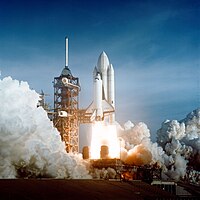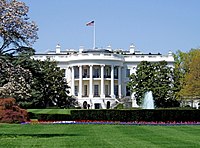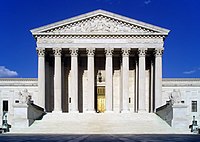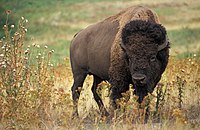MarshalN20 (talk | contribs) |
MarshalN20 (talk | contribs) |
||
| Line 223: | Line 223: | ||
==Culture== |
==Culture== |
||
{{Main|Culture of the United States}} |
{{Main|Culture of the United States}} |
||
{{See also|Social class in the United States|Public holidays in the United States|Tourism in the United States}} |
|||
[[File:EdwardMoran-UnveilingTheStatueofLiberty1886Large.jpg|left|thumb|The [[Statue of Liberty]] in [[New York City]] is a symbol of both the U.S. and ideals of freedom, democracy, and opportunity.<ref>{{cite web| title = Statue of Liberty| work=World Heritage| publisher=UNESCO| url = http://whc.unesco.org/en/list/307| accessdate = October 20, 2011}}</ref>]] |
[[File:EdwardMoran-UnveilingTheStatueofLiberty1886Large.jpg|left|thumb|The [[Statue of Liberty]] in [[New York City]] is a symbol of both the U.S. and ideals of freedom, democracy, and opportunity.<ref>{{cite web| title = Statue of Liberty| work=World Heritage| publisher=UNESCO| url = http://whc.unesco.org/en/list/307| accessdate = October 20, 2011}}</ref>]] |
||
{{clear}} |
|||
The United States has a diverse makeup of nationalities, home to a wide variety of ethnic groups, traditions, and values.<ref name="DD"/><ref name="Society in Focus">Thompson, William; Hickey, Joseph (2005). ''Society in Focus''. Boston: Pearson. ISBN 0-205-41365-X.</ref> Aside from the relatively small [[Native Americans in the United States|Native American]] and [[Native Hawaiians|Native Hawaiian]] populations, nearly all Americans or their ancestors settled or immigrated within the past five centuries.<ref>Fiorina, Morris P.; Peterson, Paul E. (2000). ''The New American Democracy''. London: Longman, p. 97. ISBN 0-321-07058-5.</ref> Mainstream American culture is a [[Western culture]] largely derived from the [[European American|traditions of European immigrants]] with influences from many other sources, such as [[African-American culture|traditions brought by slaves from Africa]].<ref name="DD"/><ref>Holloway, Joseph E. (2005). ''Africanisms in American Culture'', 2d ed. Bloomington: Indiana University Press, pp. 18–38. ISBN 0-253-34479-4. Johnson, Fern L. (1999). ''Speaking Culturally: Language Diversity in the United States''. Thousand Oaks, Calif., London, and New Delhi: Sage, p. 116. ISBN 0-8039-5912-5.</ref> More recent immigration from [[Asian American|Asia]] and especially [[Latin American culture|Latin America]] has added to a cultural mix that has been described as both a homogenizing [[melting pot]], and a heterogeneous [[salad bowl (cultural idea)|salad bowl]] in which immigrants and their descendants retain distinctive cultural characteristics.<ref name="DD"/> |
|||
Core American culture was established by [[Protestant]] British colonists and shaped by the [[frontier]] settlement process, with the traits derived passed down to descendants and transmitted to immigrants through assimilation. Americans have traditionally been characterized by a strong [[work ethic]], competitiveness, and individualism, as well as a unifying belief in an "American Creed" emphasizing liberty, equality, private property, democracy, rule of law, and a preference for limited government.<ref>{{cite book|last=Huntington|first=Samuel P.|title=Who are We?: The Challenges to America's National Identity|year=2004|publisher=Simon and Schuster|url=http://books.google.com/books?id=6xiYiybkE8kC&vq=core&source=gbs_navlinks_s|chapter=Chapters 2–4}}</ref> Americans are extremely charitable by global standards. According to a 2006 British study, Americans gave 1.67% of GDP to charity, more than any other nation studied, more than twice the second place British figure of 0.73%, and around twelve times the French figure of 0.14%.<ref>{{cite news|last=AP|title=Americans give record $295B to charity|url=http://usatoday30.usatoday.com/news/nation/2007-06-25-charitable_N.htm?POE=click-refer|accessdate=October 4, 2013|newspaper=USA Today|date=June 25, 2007}}</ref><ref>{{cite web|title=International comparisons of charitable giving|url=http://www.cafonline.org/pdf/International%20Comparisons%20of%20Charitable%20Giving.pdf|publisher=Charities Aid Foundation|accessdate=October 4, 2013|month=November|year=2006}}</ref> |
|||
American culture is considered the most [[individualism|individualistic]] in the world.<ref>{{cite web|url=http://www.clearlycultural.com/geert-hofstede-cultural-dimensions/individualism/|title=Individualism| publisher = Clearly Cultural|accessdate=February 28, 2009}}</ref> The [[American Dream]], or the perception that Americans enjoy high [[social mobility]], plays a key role in attracting immigrants.<ref name="socialmobility">{{cite web |url= http://www.oecd.org/tax/public-finance/chapter%205%20gfg%202010.pdf |title=A Family Affair: Intergenerational Social Mobility across OECD Countries |publisher=OECD| work = Economic Policy Reforms: Going for Growth|year=2010 |accessdate=September 20, 2010}} {{cite web |url= http://www.suttontrust.com/reports/IntergenerationalMobility.pdf |title=Intergenerational Mobility in Europe and North America|author=Blanden, Jo; Gregg, Paul; Malchin, Stephen |publisher= Centre for Economic Performance |month=April |year=2005 |archiveurl= http://web.archive.org/web/20060623094610/http://www.suttontrust.com/reports/IntergenerationalMobility.pdf |archivedate= June 23, 2006}}</ref> Social mobility is actually lower than other high-income countries, with the OECD ranking the U.S. 10th behind France, Germany, Canada, Australia, and the [[Nordic countries]],<ref name="socialmobility"/><ref>Dave Serchuk. [http://www.forbes.com/sites/daveserchuk/2011/12/07/happy-countrysocial-mobility/ Happy Country=Social Mobility?] ''[[Forbes]].'' 12/7/2011</ref><ref>Gould, Elise (October 10, 2012). [http://www.epi.org/publication/usa-lags-peer-countries-mobility/ "U.S. lags behind peer countries in mobility."] ''[[Economic Policy Institute]].'' Retrieved July 15, 2013.</ref><ref name=CAP>CAP: ''[http://www.americanprogress.org/issues/2006/04/b1579981.html Understanding Mobility in America]''. April 26, 2006</ref> This has been partly attributed to the depth of [[Poverty in the United States|American poverty]], which leaves poor children starting especially far behind.<ref name=DeParle>DeParle, Jason (January 4, 2012). [http://www.nytimes.com/2012/01/05/us/harder-for-americans-to-rise-from-lower-rungs.html?sq=mobility&st=cse&scp=1&pagewanted=all Harder for Americans to Rise From Lower Rungs]. ''[[The New York Times]]''. Retrieved September 8, 2013.</ref> Such studies are based on relative comparisons within each nation rather than absolute wealth earned throughout one's life, the U.S. having both a more stretched-out income distribution and a higher [[median household income|median income]] than those nations.<ref name=Schneider>{{cite web |last=Schneider |first=Donald |title=A Guide to Understanding International Comparisons of Economic Mobility |url= http://www.heritage.org/research/reports/2013/07/a-guide-to-understanding-international-comparisons-of-economic-mobility |publisher=The Heritage Foundation |accessdate=August 22, 2013 |date=July 29, 2013}}</ref> While the mainstream culture holds that the United States is a [[classless society]],<ref>{{cite book |last=Gutfield |first=Amon |year=2002 |title=American Exceptionalism: The Effects of Plenty on the American Experience |publisher=Sussex Academic Press |location=Brighton and Portland |page=65 |isbn=1-903900-08-5}}</ref> scholars identify significant differences between the country's social classes, affecting [[socialization]], language, and values.<ref>{{cite book |last=Zweig |first=Michael |year=2004 |title=What's Class Got To Do With It, American Society in the Twenty-First Century |publisher=Cornell University Press |location=Ithaca, NY |isbn=0-8014-8899-0}} {{cite web |url= http://eric.ed.gov/ERICWebPortal/Home.portal?_nfpb=true&_pageLabel=RecordDetails&ERICExtSearch_SearchValue_0=ED309843&ERICExtSearch_SearchType_0=eric_accno&objectId=0900000b800472a5 |title=Effects of Social Class and Interactive Setting on Maternal Speech |publisher=Education Resource Information Center |accessdate=January 27, 2007}}</ref> |
|||
Americans' self-images, social viewpoints, and cultural expectations are associated with their occupations to an unusually close degree.<ref>{{cite book |last=Eichar |first=Douglas |year=1989 |title=Occupation and Class Consciousness in America |publisher=Greenwood Press |location=Westport, CT |isbn=0-313-26111-3}}</ref> While Americans tend greatly to value socioeconomic achievement, being [[Average Joe|ordinary or average]] is generally seen as a positive attribute.<ref>{{cite book |last=O'Keefe |first=Kevin |year=2005 |title=The Average American |publisher=PublicAffairs |location=New York |isbn=1-58648-270-X}}</ref> |
|||
==See also== |
==See also== |
||
Revision as of 12:49, 3 July 2014
United States of America | |
|---|---|
| Motto: | |
| Anthem: "The Star-Spangled Banner" | |
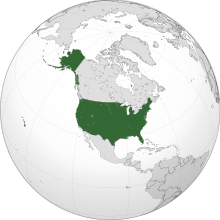 | |
| Capital | Washington, D.C. |
| Largest city | New York City |
| Official languages | None at federal level[a] |
| National language | American English[b] |
| Demonym(s) | American |
| Government | Federal presidential constitutional republic |
| Barack Obama (D) | |
| Joe Biden (D) | |
| John Boehner (R) | |
| John Roberts | |
| Legislature | Congress |
| Senate | |
| House of Representatives | |
| Independence from Great Britain | |
• Declared | July 4, 1776 |
| September 3, 1783 | |
| June 21, 1788 | |
| Area | |
• Total | 9,826,675 km2 (3,794,100 sq mi)[4][c] (3rd/4th) |
• Water (%) | 6.76 |
| Population | |
• 2013 estimate | 336,565,000[5] (3rd) |
• Density | 34.2/km2 (88.6/sq mi) (179th) |
| GDP (PPP) | 2013 estimate |
• Total | $16.724 trillion[6] (1st) |
• Per capita | $52,839[6] (6th) |
| GDP (nominal) | 2013 estimate |
• Total | $16.724 trillion[6] (1st) |
• Per capita | $52,839[6] (9th) |
| Gini (2011) | 47.7[7] high (39th (2009)) |
| HDI (2013) | very high (3rd) |
| Currency | [[]] ($) (USD) |
| Time zone | UTC−5 to −10 |
• Summer (DST) | UTC−4 to −10[e] |
| Driving side | right[g] |
| Calling code | +1 |
| ISO 3166 code | US |
| Internet TLD | .us .gov .mil .edu |
| |
The United States, officially the United States of America, is a country in northern North America. Its contiguous territory is bordered in the north by Canada, in the south by Mexico, in the west by the Pacific Ocean, and in the east by the Atlantic Ocean. Its non-contiguous territory extends the country's borders worldwide. At 4 square miles (9.83 square kilometres) in total, the United States is the fourth-largest country by total area.
The U.S. mainland was originally inhabited by various Native American civilizations. Europeans colonized the region beginning in the 16th century. After obtaining independence from Great Britain in 1783, the United States developed into a major regional power in the Western Hemisphere, and underwent territorial expansion under the doctrine of manifest destiny. The territorial integrity of the state was consolidated following a civil war, and the U.S. thereafter entered a Gilded Age of increasing industrialization, immigration, and social reform. In the twentieth century, the country's leading role in two world wars confirmed its status as a global superpower and a permanent member of the United Nations Security Council. After the end of a decades-long Cold War with the Soviet Union, the United States became the world's foremost economic, military, and technological power.
The United States is a federal republic divided into 50 states, 16 territories, a federal district, and various overseas extraterritorial jurisdictions. Its diverse geography include the vast Interior Plains, arctic Alaska, tropical Hawaii, the valleys of its Appalachian highlands, and the arid deserts of its Southwest. It is a developed country with a very high Human Development Index. Its national economy is the world's largest, and it is fueled by an abundance of natural resources, a well-developed infrastructure, and a large manufacturing sector.
The U.S. population, estimated at 316 million, is the third largest in the world. Americans are multiethnic and multicultural, the product of large-scale immigration. The main spoken language is English, and a significant number of the nation's inhabitants also speak Spanish. At the forefront of its national identity, the U.S. has traditionally upheld the ideals of freedom, democracy, and opportunity.
Etymology
In 1507, the German cartographer Martin Waldseemüller produced a world map on which he named the lands of the Western Hemisphere "America" after the Italian explorer and cartographer Amerigo Vespucci.[11]
The first documentary evidence of the phrase "United States of America" is from a letter dated January 2, 1776, written by Stephen Moylan, Esq., George Washingon's aide-de-camp and Muster-Master General of the Continental Army. Addressed to Lt. Col. Joseph Reed, Moylan expressed his wish to carry the "full and ample powers of the United States of America" to Spain to assist in the revolutionary war effort.[12]
The first publicly published evidence of the phrase "United States of America" was in an anonymously written essay in The Virginia Gazette newspaper in Williamsburg, Virginia, on April 6, 1776.[13][14] In June 1776, Thomas Jefferson included the phrase "UNITED STATES OF AMERICA" in all capitalized letters in the headline of his "original Rough draught" of the Declaration of Independence.[15][16] In the final Fourth of July version of the Declaration, the pertinent section of the title was changed to read, "The unanimous Declaration of the thirteen united States of America".[17]
In 1777 the Articles of Confederation announced, "The Stile of this Confederacy shall be 'The United States of America'".[18]
The short form "United States" is also standard. Other common forms include the "U.S.", the "USA", and "America". Colloquial names include the "U.S. of A." and, internationally, the "States". "Columbia", a name popular in poetry and songs of the late 1700s,[19] derives its origin from Christopher Columbus; it appears in the name "District of Columbia".
The standard way to refer to a citizen of the United States is as an "American". "United States", "American" and "U.S." are used to refer to the country adjectivally ("American values", "U.S. forces"). "American" is rarely used in English to refer to subjects not connected with the United States.[20]
The phrase "United States" was originally treated as plural, a description of a collection of independent states—e.g., "the United States are"—including in the Thirteenth Amendment to the United States Constitution, ratified in 1865. It became common to treat it as singular, a single unit—e.g., "the United States is"—after the end of the Civil War. The singular form is now standard; the plural form is retained in the idiom "these United States".[21] The difference has been described as more significant than one of usage, but reflecting the difference between a collection of states and a unit.[22]
In non-English languages, the name is frequently translated as the translation of either the "United States" or "United States of America", and colloquially as "America". In addition, an initialism is sometimes used.[23]
History
Government
States and territories

Geography
Biodiversity
Economy

Demographics

The U.S. Census Bureau estimates the country's population now to be 336,565,000,[5] including an approximate 11.2 million illegal aliens.[25] The U.S. population almost quadrupled during the 20th century, from about 76 million in 1900.[26] The third most populous nation in the world, after China and India, the United States is the only major industrialized nation in which large population increases are projected.[27]
With a birth rate of 13 per 1,000, 35% below the world average, its population growth rate is positive at 0.9%, significantly higher than those of many developed nations.[28] In fiscal year 2012, over one million immigrants (most of whom entered through family reunification) were granted legal residence.[29] Mexico has been the leading source of new residents for over two decades; since 1998, China, India, and the Philippines have been in the top four sending countries every year.[30][31] 9 million Americans identify as homosexual, bisexual or transgender, making up less than four percent of the population.[32] A 2010 survey found that seven percent of men and eight percent of women identified as gay, lesbian or bisexual.[33]
The United States has a very diverse population—31 ancestry groups have more than one million members.[34] White Americans are the largest racial group; German Americans, Irish Americans, and English Americans constitute three of the country's four largest ancestry groups.[34] Black Americans are the nation's largest racial minority and third largest ancestry group.[34] Asian Americans are the country's second largest racial minority; the three largest Asian American ethnic groups are Chinese Americans, Filipino Americans, and Indian Americans.[34]
Culture
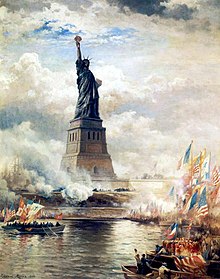
See also
- Index of United States-related articles
- Outline of the United States
- List of United States cities by population
- List of metropolitan areas of the United States
- List of official United States national symbols
- Template:Wikipedia books link
References
- ^ 36 U.S.C. § 302 National motto
- ^ Simonson, 2010
- ^ Dept. of Treasury, 2011
- ^ Cite error: The named reference
WFwas invoked but never defined (see the help page). - ^ a b "U.S. POPClock Projection". U.S. Census Bureau. (figure updated automatically).
- ^ a b c d "World Economic Outlook Database: United States". International Monetary Fund. 2013. Retrieved November 5, 2013.
{{cite web}}: Unknown parameter|month=ignored (help) - ^ "Income, Poverty and Health Insurance Coverage in the United States: 2011". Newsroom. United States Census Bureau. September 12, 2012. Retrieved January 23, 2013.
- ^ "Human Development Report 2013" (PDF). United Nations Development Programme. March 14, 2013. Retrieved March 14, 2013.
- ^ Cite error: The named reference
ILWwas invoked but never defined (see the help page). - ^ "Ecological Footprint Atlas 2010" (PDF). Global Footprint Network. Retrieved July 11, 2011.
- ^ "Cartographer Put 'America' on the Map 500 years Ago". USA Today. Washington, D.C. Associated Press. April 24, 2007. Retrieved November 30, 2008.
- ^ DeLear, Byron (July 4, 2013) Who coined 'United States of America'? Mystery might have intriguing answer. "Historians have long tried to pinpoint exactly when the name 'United States of America' was first used and by whom. A new find suggests the man might have been George Washington himself." Christian Science Monitor (Boston, MA).
- ^ "To the inhabitants of Virginia," by A PLANTER. Dixon and Hunter's Virginia Gazette #1287 – April 6, 1776, Williamsburg, Virginia. Letter is also included in Peter Force's American Archives Vol. 5
- ^ Carter, Rusty (August 18, 2012). "You read it here first"[dead link]. Virginia Gazette. "He did a search of the archives and found the letter on the front page of the April 6, 1776, edition, published by Hunter & Dixon."
- ^ DeLear, Byron (August 16, 2012). "Who coined the name 'United States of America'? Mystery gets new twist." Christian Science Monitor (Boston, MA).
- ^ Jefferson's "original Rough draught" of the Declaration of Independence
- ^ "The Charters of Freedom". National Archives. Retrieved June 20, 2007.
- ^ Mary Mostert (2005). The Threat of Anarchy Leads to the Constitution of the United States. CTR Publishing, Inc. p. 18. ISBN 9780975385142.
- ^ "Get to Know D.C." Historical Society of Washington, D.C. Retrieved July 11, 2011.
- ^ Wilson, Kenneth G. (1993). The Columbia Guide to Standard American English. New York: Columbia University Press, pp. 27–28. ISBN 0-231-06989-8.
- ^ Zimmer, Benjamin (November 24, 2005). "Life in These, Uh, This United States". University of Pennsylvania—Language Log. Retrieved January 5, 2013.
- ^ G. H. Emerson, The Universalist Quarterly and General Review, Vol. 28 (Jan. 1891), p. 49, quoted in Zimmer paper above.
- ^ For example, the U.S. embassy in Spain calls itself the embassy of the "Estados Unidos", literally the words "states" and "united", and also uses the initials "EE.UU.", the doubled letters implying plural use in Spanish [1] Elsewhere on the site "Estados Unidos de América" is used [2]
- ^ "Market highlights for first half-year 2010" (PDF). World Federation of Exchanges. Retrieved November 22, 2012.
- ^ Camarota, Steven A.; Jensenius, Karen (2008). "Homeward Bound: Recent Immigration Enforcement and the Decline in the Illegal Alien Population" (PDF). Center for Immigration Studies. Retrieved August 6, 2008.
{{cite web}}: Unknown parameter|month=ignored (help)CS1 maint: multiple names: authors list (link) - ^ "Statistical Abstract of the United States" (PDF). United States Census Bureau. 2005.
- ^ "Executive Summary: A Population Perspective of the United States". Population Resource Center. 2000. Archived from the original on June 4, 2007. Retrieved December 20, 2007.
{{cite web}}: Unknown parameter|month=ignored (help) - ^ "Births: Preliminary Data for 2010" (PDF). National Vital Statistics Reports, Volume 60. National Center for Health Statistics. 2011. Retrieved August 17, 2012.
- ^ "U.S. Legal Permanent Residents: 2012". Office of Immigration Statistics Annual Flow Report.
- ^ "Yearbook of Immigration Statistics: 2011 – Persons Obtaining Legal Permanent Resident Status by Region and Country of Birth: Fiscal Years 2002 to 2011 (Table 3)". U.S. Dept. of Homeland Security. Retrieved February 4, 2013.
- ^ "Yearbook of Immigration Statistics: 2007 – Persons Obtaining Legal Permanent Resident Status by Region and Country of Birth: Fiscal Years 1998 to 2007 (Table 3)". U.S. Dept. of Homeland Security. Retrieved February 4, 2013.
- ^ Donaldson James, Susan (April 8, 2011). "Gay Americans Make Up 4 Percent of Population". ABC News. Retrieved August 26, 2012.
- ^ National Survey of Sexual Health and Behavior. Retrieved January 6, 2013.
- ^ a b c d "Ancestry 2000" (PDF). U.S.Census Bureau. 2004. Retrieved June 13, 2007.
{{cite web}}: Unknown parameter|month=ignored (help) - ^ "Statue of Liberty". World Heritage. UNESCO. Retrieved October 20, 2011.
Bibliography
- Acharya, Viral V.; Cooley, Thomas F.; Richardson, Matthew P.; Walter, Ingo (2010). Regulating Wall Street: The Dodd-Frank Act and the New Architecture of Global Finance.
Wiley. p. 592. ISBN 978-0470768778. - Barth, James; Jahera, John (2010). "US Enacts Sweeping Financial Reform Legislation". Journal of Financial Economic Policy. 2 (3): 192–195. doi:10.1108/17576381011085412.
- Berkin, Carol; Miller, Christopher L.; Cherny, Robert W.; Gormly, James L. (2007). Making America: A History of the United States, Volume I: To 1877. Cengage Learning. p. 75., Book
- Bianchine, Peter J.; Russo, Thomas A. (1992). "The Role of Epidemic Infectious Diseases in the Discovery of America,
(Allergy and Asthma Proceedings)". 13 (5).
OceanSide Publications, Inc.: 225–232. doi:10.2500/108854192778817040. Retrieved September 9, 2012.{{cite journal}}: Cite journal requires|journal=(help) - Boyer, Paul S.; Clark, Cliffoed E. Jr.; Kett, Joseph F. (2007).
The Enduring Vision: A History of the American People. Cengage Learning. p. 588. ISBN 9780618801619.{{cite book}}: Unknown parameter|coauthors=ignored (|author=suggested) (help), Book - Clingan, Edmund. An Introduction to Modern Western Civilization. iUniverse. ISBN 9781462054398., Book
- Calloway, Colin G. New Worlds for All: Indians, Europeans, and the Remaking of Early America.
JHU Press. p. 229. ISBN 9780801859595., Book - Davis, Kenneth C. (1996). Don't know much about the Civil War. New York: William Marrow and Co. p. 518. ISBN 0-688-11814-3., Book
- Daynes, Byron W.; Sussman, Glen (eds.) (2010). White House Politics and the Environment: Franklin D. Roosevelt to George W. Bush.
Texas A&M University Press. p. 320. ISBN 9781603442541.Presidential environmental policies, 1933–2009
{{cite book}}:|first2=has generic name (help), Book - Feldstein, Sylvan G.; Fabozzi, CFA, Frank J. The Handbook of Municipal Bonds.
John Wiley & Sons, Jan 13, 2011. p. 1376. ISBN 9781118044940., Book - Gold, Susan Dudley (2006). United States V. Amistad: Slave Ship Mutiny.
Marshall Cavendish. p. 144. ISBN 9780761421436., Book - Ferguson, Thomas; Rogers, Joel (1986). "The Myth of America's Turn to the Right". The Atlantic. 257 (5): 43–53. Retrieved March 11, 2013.
- Fraser, Seve; Gerstle, Gary (1989). The Rise and Fall of the New Deal Order: 1930–1980. American History: Political science.
Princeton University Press. p. 311. ISBN 9780691006079. - Gordon, John Steele (2004). An Empire of Wealth: The Epic History of American Economic Power. HarperCollins., Book
- Graebner, Norman A.; Burns, Richard Dean; Siracusa, Joseph M. (2008). Reagan, Bush, Gorbachev: Revisiting the End of the Cold War. Praeger Security International Series.
Greenwood Publishing Group. p. 180. ISBN 9780313352416. - Hughes, David (2007). The British Chronicles. Vol. 1. Westminister, Maryland:
Heritage Books. p. 347. - Jacobs, Lawrence R. (2010). Health Care Reform and American Politics: What Everyone Needs to Know: What Everyone Needs to Know.
Oxford University Press. ISBN 9780199781423. - Johnson, Paul (1997). A History of the American People. HarperCollins. pp. 26–30., eBook version
- Juergens, Tom (2011). Wicked Puritans of Essex County.
The History Press. p. 112. ISBN 9781596295667., Book - Kessel, William B.; Wooster, Robert (2005). Encyclopedia of Native American Wars and Warfare. Facts on File library of American History.
Infobase Publishing. p. 398. ISBN 9780816033379., Book - Kolko, Gabriel (1988). Confronting the Third World: United States Foreign Policy, 1945–1980. New York, NY: Pantheon.
{{cite book}}: Invalid|ref=harv(help) - Leckie, Robert (1990). None died in vain: The Saga of the American Civil War. New York: Harper-Collins. p. 682. ISBN 0-06-016280-5., Book
- Leffler, Melvyn P. (2010). "The emergence of an American grand strategy, 1945–1952".
In Melvyn P. Leffler and Odd Arne Westad, eds.,The Cambridge History of the Cold War, Volume 1: Origins (pp. 67–89).
Cambridge: Cambridge University Press. ISBN 978-0-521-83719-4.{{cite book}}: Invalid|ref=harv(help) - Lemon, James T. (1987). "Colonial America in the 18th Century". In Robert D. Mitchell; Paul A. Groves (eds.). North America: the historical geography of a changing continent. Rowman & Littlefield., PDF
- Lien, Ph.D, Arnold Johnson (1913). Studies in History, Economics, and Public Law, Volume 54. Longmans, Green & Co., Agents, London; Columbia University, New York. p. 604.
- Karen Wood Weierman (2005). One Nation, One Blood: Interracial Marriage In American Fiction, Scandal, And Law, 1820–1870.
University of Massachusetts Press. p. 214. ISBN 978-1-55849-483-1., Book - Levenstein, Harvey (2003). Revolution at the Table: The Transformation of the American Diet.
University of California Press, Berkeley, Los Angeles. ISBN 0-520-23439-1. - Mann, Kaarin (2007). "Interracial Marriage In Early America: Motivation and the Colonial Project" (PDF). Michigan Journal of History (Fall).
University of Michigan. Retrieved September 8, 2012. - Price, David A. (2003). Love and Hate in Jamestown: John Smith, Pocahontas, and the Start of a New Nation. Random House. eBook version
- Quirk, Joel (2011). The Anti-Slavery Project: From the Slave Trade to Human Trafficking.
University of Pennsylvania Press. p. 344. ISBN 978-0-8122-4333-8., Book - Ranlet, Philip (1999). Alden T. Vaughan (ed.). New England Encounters: Indians and Euroamericans Ca. 1600–1850.
North Eastern University Press. - Rausch, David A. (1994). Native American Voices.
Baker Books, Grand Rapids. p. 180., Book - Remini, Robert V. (2007). The House: The History of the House of Representatives. HarperCollins. pp. 2–3., Book
- Ripper, Jason (2008). American Stories: To 1877.
M.E. Sharpe. p. 299. ISBN 9780765629036., Book - Russell, John Henderson (1913). The Free Negro in Virginia, 1619–1865. Johns Hopkins University. p. 196., E'Book
- Schneider, Dorothy; Schneider, Carl J. (2007). Slavery in America. Infobase Publishing. p. 554. ISBN 9781438108131., Book
- Schultz, David Andrew (2009). Encyclopedia of the United States Constitution.
Infobase Publishing. p. 904. ISBN 9781438126777., Book - Simonson, Peter (2010). Refiguring Mass Communication: A History. Urbana: University of Illinois Press. ISBN 9780252077050.
He held high the Declaration of Independence, the Constitution, and the nation's unofficial motto, e pluribus unum, even as he was recoiling from the party system in which he had long participated.
, Book - Smith, Andrew F. (2004). The Oxford Encyclopedia of Food and Drink in America.
New York: Oxford University Press, pp. 131–32. ISBN 0-19-515437-1. - Soss, Joe (2010). Hacker, Jacob S.; Mettler, Suzanne (eds.). Remaking America: Democracy and Public Policy in an Age of Inequality.
Russell Sage Foundation. ISBN 9781610446945., Book - Tadman, Michael (2000). The Demographic Cost of Sugar: Debates on Slave Societies and Natural Increase in the Americas. Vol. 105. Oxford University Press.
{{cite book}}:|journal=ignored (help), Article - Taylor, Alan (2002). Eric Foner (ed.). American Colonies: The Settling of North America. Penguin Books, New York. ISBN 0-670-87282-2., Book
- Thornton, Russell (1987). American Indian Holocaust and Survival: A Population History Since 1492. Volume 186 of Civilization of the American Indian Series.
University of Oklahoma Press. p. 49. ISBN 9780806122205., Book - Tooze, Adam (2006). The Wages of Destruction: The Making and Breaking of the Nazi Economy.
London: Allen Lane. ISBN 978-0-713-99566-4.{{cite book}}: Invalid|ref=harv(help) - Vaughan, Alden T. (1999). New England Encounters: Indians and Euroamericans Ca. 1600–1850.
North Eastern University Press. - Walton, Gary M.; Rockoff, Hugh (2009). History of the American Economy. Cengage Learning., Book
- Williams, Daniel K. (2012). "Questioning Conservatism's Ascendancy: A Reexamination of the Rightward Shift in Modern American Politics; {Reviews in American History}" (PDF). 40 (2).
The Johns Hopkins University Press: 325–331. doi:10.1353/rah.2012.0043. Retrieved March 11, 2013.{{cite journal}}: Cite journal requires|journal=(help) - Zinn, Howard (2005). A People's History of the United States. HarperCollins. ISBN 0060838655.
Website sources
- "Country Profile: United States of America". BBC News. London. April 22, 2008. Retrieved May 18, 2008.
- Cohen, Eliot A. (July/August 2004). "History and the Hyperpower". Foreign Affairs. Washington D.C. Retrieved July 14, 2006.
{{cite web}}: Check date values in:|date=(help) - "Slavery and the Slave Trade in Rhode Island".
- "Peopling of Americas". Smithsonian Institution, National Museum of Natural History. 2004. Archived from the original on November 28, 2007. Retrieved June 19, 2007.
{{cite web}}: Unknown parameter|month=ignored (help) - "History of "In God We Trust"". U.S. Department of the Treasury. March 8, 2011. Retrieved February 23, 2013.
- "Early History, Native Americans, and Early Settlers in Mercer County". Mercer County Historical Society. 427. Archived from the original on April 15, 2013., Book
- Nick Hayes (November 6, 2009). "Looking back 20 years: Who deserves credit for ending the Cold War?". MinnPost. Retrieved March 11, 2013.
- "59e. The End of the Cold War". U.S. History.org. Independence Hall Association. Retrieved March 10, 2013.
- Levy, Peter B. (1996). Encyclopedia of the Reagan-Bush Years. ABC-CLIO. p. 442. ISBN 9780313290183.
- Wallander, Celeste A. (2003). "Western Policy and the Demise of the Soviet Union". Journal of Cold War Studies. 5 (4). President and Fellows of Harvard College and the Massachusetts Institute of Technology: 137–177. doi:10.1162/152039703322483774. Retrieved March 11, 2013.


